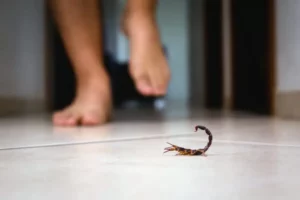Home / Blog / Bed Bugs / The Dangers of DIY Bed Bugs Removal: Why Professional Help Is Essential
The Dangers of DIY Bed Bugs Removal: Why Professional Help Is Essential

Scientifically reviewed by Rachel Maldonado
-Published on July 25, 2023
-Updated on August 29, 2025
The Dangers of DIY Bed Bugs Removal: Why Professional Help Is Essential
If you’ve ever dealt with bed bugs, you know how frustrating—and exhausting—they can be. These tiny pests are notorious for causing physical discomfort, emotional stress, and sleepless nights. When facing an infestation, you might be tempted to try DIY bed bugs removal as a quick, cost-saving solution.
But here’s the truth: DIY bed bug treatment rarely works, and in many cases, it can make the problem worse.
Let’s break down the risks of going the DIY route, why professional help is usually the better option, and what you should do instead to truly get rid of bed bugs for good.
Does DIY Bed Bugs Removal Actually Work?
Many homeowners turn to home remedies like essential oils, foggers, or store-bought sprays in an effort to kill bed bugs without calling in the pros. Unfortunately, there’s little evidence to support the effectiveness of most of these methods.
Take essential oils, for example. While some oils (like tea tree or lavender) may have mild insecticidal properties, they are typically not strong enough to eliminate a full infestation—especially when bed bugs and their eggs are well-hidden. In fact, improperly used oils and sprays can even be harmful to pets and children.
The same goes for DIY heat treatments. While heat can be effective when applied correctly, it’s only successful when temperatures are precisely controlled and sustained for long periods—something that’s nearly impossible to do safely without professional-grade equipment.
Bottom line? Without the right tools and expertise, DIY bed bugs removal often leads to wasted time, increased frustration, and a growing infestation.
Why DIY Bed Bug Treatment Can Be Dangerous
There are many myths surrounding bed bug treatment, and one of the most persistent is the idea that home remedies are “just as good” as professional ones. Let’s break down the key reasons this approach can backfire.
1. You Might Not Eliminate the Infestation
Killing a few visible bugs doesn’t mean the problem is solved. Bed bugs reproduce quickly and are experts at hiding in hard-to-reach places like mattress seams, electrical outlets, and cracks in baseboards. Partial treatments may reduce numbers temporarily, but they won’t eliminate the root of the infestation.
2. Hidden Bed Bugs Are Easy to Miss
Another problem with DIY bed bug treatment is that you may not be able to get to all the bugs. Bed bugs are incredibly What you see is rarely the full extent of the problem. Bed bugs are nocturnal and prefer tight, dark hiding spots. Even if it seems like your DIY method worked, chances are there are still dozens—or hundreds—of bugs and eggs you didn’t reach.
3. Chemical Exposure Risks
Most over-the-counter pest control products contain chemicals that require careful handling. Without proper training, you risk exposure to toxic ingredients that can cause respiratory issues, skin irritation, or allergic reactions. This is especially dangerous in homes with children or pets.
The EPA even warns against unapproved DIY bed bugs treatment methods due to health and safety concerns.
4. More Time for Bed Bugs to Spread
Delays in effective treatment give bed bugs time to breed and spread throughout your home. The longer they’re left untreated, the harder it becomes to fully get rid of bed bugs—and the more rooms they’re likely to infest.
5. DIY Heat Treatments Can Be a Fire Hazard
Many DIY heat methods involve space heaters or makeshift enclosures, which can easily lead to overheating or even fire. Professionals use controlled, industrial equipment designed to deliver safe and even heat without putting your property—or your family—at risk.
Signs of Bed Bugs
Not sure if bed bugs are the issue? Here are some of the most common warning signs:
- Small reddish-brown bugs or shed skins in bedding or furniture
- Tiny blood stains or dark spots (excrement) on sheets and mattresses
- Clusters of itchy bites, especially on arms, legs, or exposed skin
- A musty, sweet odor in heavily infested areas
If you spot any of these signs, don’t wait—early intervention is key to stopping the spread before it becomes worse (and harder to eliminate).
How to Get Rid of Bed Bugs
To fully get rid of bed bugs, you’ll need a comprehensive approach that includes:
- Inspection to identify all hiding places and assess the level of infestation
- Targeted treatments, such as safe chemical applications or heat treatments performed by trained technicians
- Preventive measures, including mattress encasements, decluttering, and sealing cracks
- Follow-up visits to ensure no bed bugs or eggs survive
How Long Does It Take to Get Rid of Bed Bugs?
The timeline can vary depending on the severity of the infestation. Minor issues may be resolved in a few days with one or two treatments. More advanced infestations may require several weeks of monitoring and follow-up care
Skip the DIY. Call Hawx Instead.
At Hawx, we understand how disruptive a bed bug problem can be. Our licensed technicians use industry-leading methods to locate infestations, eliminate bugs and eggs, and prevent future outbreaks. From heat treatments to integrated pest management.
strategies, we tailor our approach to your unique situation. Plus, we don’t just eliminate the bugs you see—we address the hidden populations, too.
You don’t have to lose sleep over bed bugs or gamble with risky DIY methods that don’t work. Contact us today for a free estimate and take the first step toward a bed bug-free home. Our team is here to help you reclaim your space, restore your peace of mind, and finally say goodbye to bed bugs—for good.
Related Articles
Visit our blog to learn more.
→







